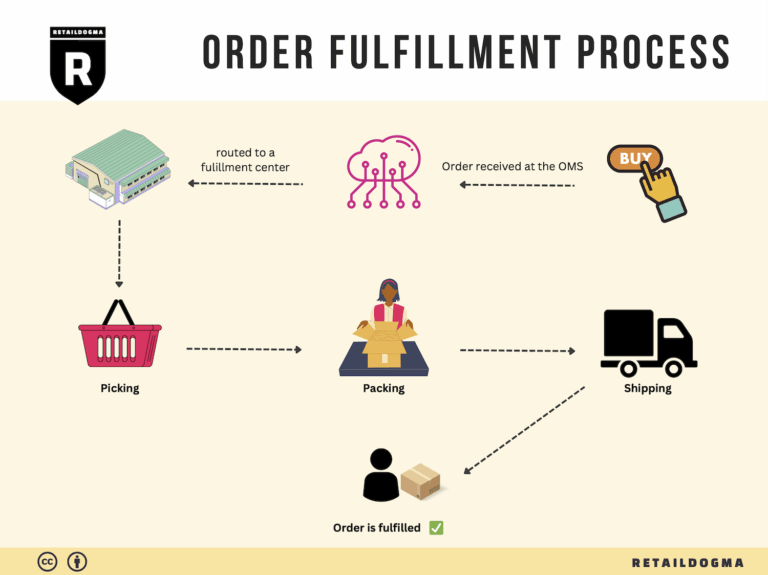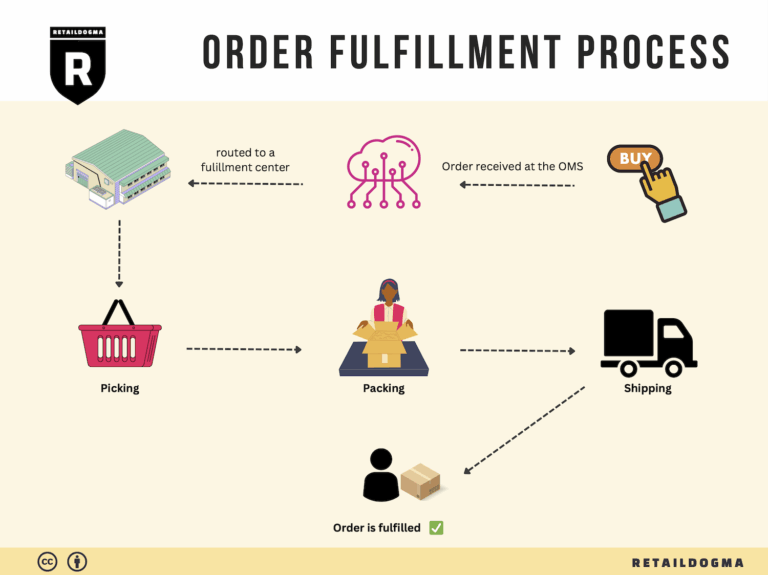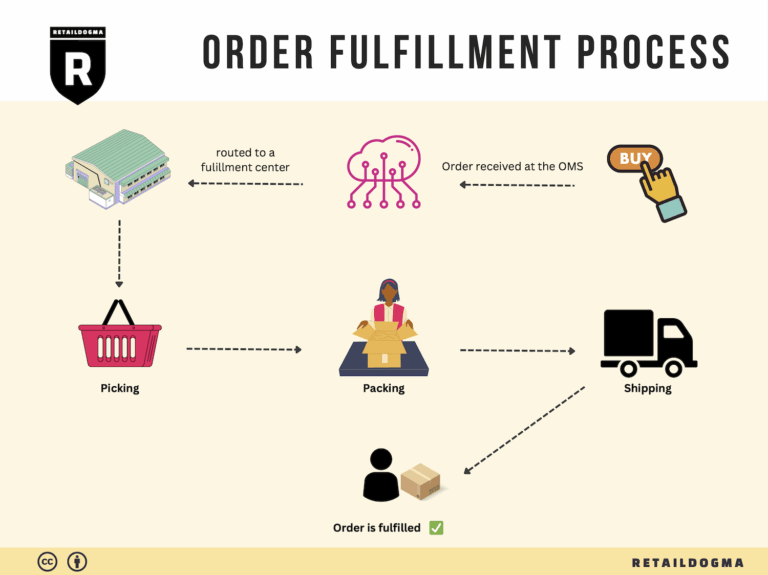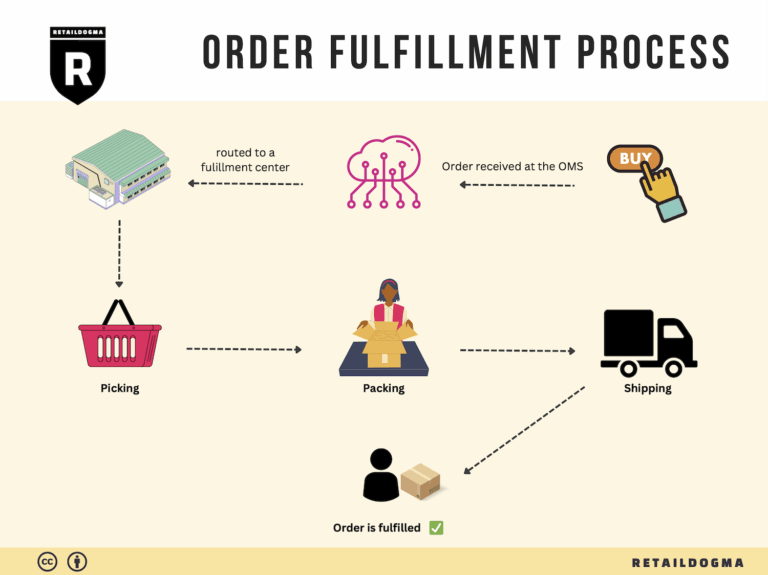What Is A Fulfillment Center? A Complete Guide (2025)
What is E-commerce Fulfillment? An Introduction for Growing Businesses
The Overwhelm of Packing and Shipping
As e-commerce businesses grow, one of the most common pain points they encounter is the overwhelming task of packing and shipping orders. Many entrepreneurs find themselves buried under boxes, tape, and shipping labels, which can distract from crucial activities like marketing, product development, and customer engagement. Managing logistics can quickly become a full-time job, leaving little room for strategic growth.
Understanding E-commerce Fulfillment
E-commerce fulfillment is simply the process of getting a product from your warehouse or storage to your customer’s doorstep. It encompasses several key activities, including inventory management, order processing, picking, packing, and shipping. The efficiency of your fulfillment operations can significantly impact customer satisfaction, repeat business, and ultimately, your bottom line.
What This Guide Will Cover
In this guide, we will explore various fulfillment models that can help streamline your operations. You’ll learn about Third-Party Logistics (3PL) providers and Fulfillment by Amazon (FBA), among other options. Each model has its unique advantages and considerations, making it vital to choose one that aligns with your business goals.
We will also delve into the core services offered by fulfillment partners. These typically include:
- Inventory Management: Keeping track of stock levels to avoid overselling or stockouts.
- Order Processing: Automating the order capture and processing stages to minimize errors.
- Picking and Packing: Efficiently selecting products and preparing them for shipment.
- Shipping: Choosing the best carriers and shipping options to balance cost and speed.
Additionally, we will provide insights on how to select the right fulfillment partner for your business. Key factors to consider include service offerings, scalability, technology integration, and customer service.
Finally, we’ll discuss pricing structures in fulfillment services, helping you understand how to budget effectively while ensuring quality service.
Empowering Your Logistics Decisions
The ultimate goal of this guide is to empower you, the business owner, to make informed decisions about your logistics strategy. By understanding the nuances of e-commerce fulfillment, you can select the right model and partner that will not only alleviate the overwhelm of packing and shipping but also enhance your customer experience and support your business growth. Let’s dive into the world of e-commerce fulfillment and simplify your logistics journey!
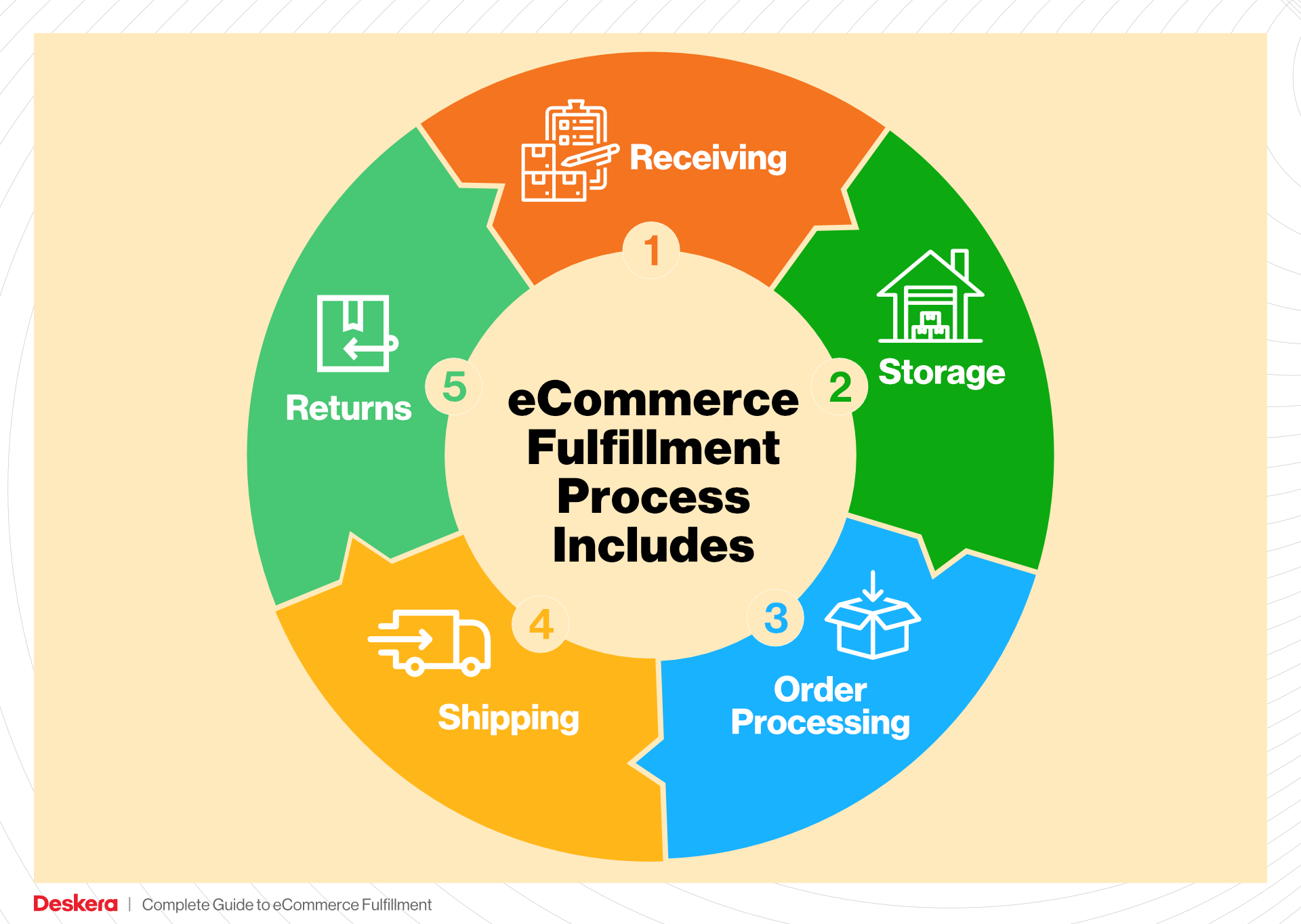
What You’ll Learn In This Guide
- What is E-commerce Fulfillment? An Introduction for Growing Businesses
- The Order Fulfillment Process: From ‘Buy’ Button to Customer’s Door
- Comparing Fulfillment Models: In-House vs. 3PL vs. Dropshipping
- A Deep Dive into Amazon FBA: Pros, Cons, and Who It’s For
- Core Services Offered by Fulfillment Centers
- How to Choose a Fulfillment Partner: A 6-Point Checklist
- Understanding Fulfillment Pricing: A Breakdown of Common Fees
- Frequently Asked Questions (FAQs) about Fulfillment
- Conclusion: Is Outsourcing Fulfillment the Right Move for Your Business?
- Important Disclaimer
The Order Fulfillment Process: From ‘Buy’ Button to Customer’s Door
1. Receiving Inventory
The order fulfillment process begins with receiving inventory, which is a critical step in ensuring that your e-commerce business operates smoothly. Upon delivery, inventory is checked against purchase orders to confirm that the correct quantities and items have arrived. This includes verifying product condition and labeling items accurately.
Importance: Efficient inventory receiving is essential for maintaining accurate stock levels and preventing discrepancies that can lead to fulfillment delays. A key term associated with this step is SKU (Stock Keeping Unit), which is a unique identifier assigned to each product. Proper SKU management helps streamline inventory tracking and retrieval processes.
2. Warehouse Storage
Once inventory is received, it is stored in a warehouse. This step involves organizing products in a way that maximizes space and facilitates easy access. Products are typically categorized based on various criteria such as size, type, or sales velocity.
Importance: Effective warehouse storage enhances retrieval speed during the picking process, which directly impacts order fulfillment times. Well-organized storage systems can reduce the time it takes to locate and pick items, ultimately improving customer satisfaction. A common term here is bin location, which refers to the specific area in the warehouse where a product is stored.
3. Order Picking
Order picking is the process of selecting items from storage to fulfill a customer order. This step can vary in complexity depending on the size of the order and the layout of the warehouse. Orders can be picked using different methods, such as single order picking, batch picking, or zone picking.
Importance: The efficiency of order picking significantly influences overall fulfillment speed. A well-optimized picking process reduces the time it takes to gather products and minimizes errors, which can lead to returns and customer dissatisfaction. A key term associated with this step is pick list, which is a document or digital tool used to guide warehouse staff in selecting the correct items and quantities for each order.
4. Order Packing
After items have been picked, they move to the packing stage. This involves securely packaging the products to ensure they reach customers in perfect condition. During this step, items are carefully placed in boxes, and protective materials are added as needed.
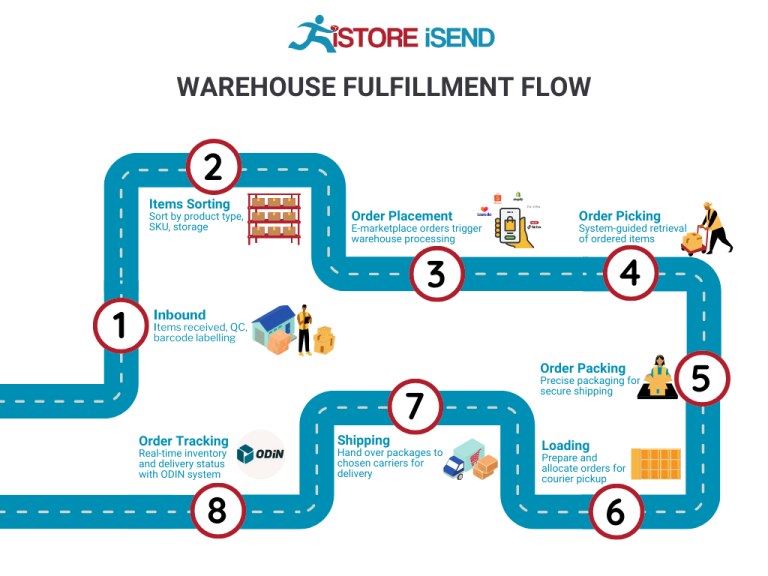
Importance: Proper packing not only safeguards products during transit but also enhances the unboxing experience for customers. This step is crucial for minimizing damage claims and returns, which can be costly for businesses. A relevant term here is packing slip, which is a document included in the package that lists the items contained within, serving as a receipt for the customer and a record for the seller.
5. Shipping & Delivery
The final step in the order fulfillment process is shipping and delivery. Once packages are packed, they are labeled and handed over to shipping carriers for delivery to the customer’s address. This step includes choosing the right shipping methods, whether standard, expedited, or same-day delivery, based on customer preferences and order urgency.
Importance: Timely and accurate shipping is vital for customer satisfaction and repeat business. Customers expect their orders to arrive on time, and delays can lead to negative reviews and lost sales. A key term in this context is last-mile delivery, which refers to the final leg of the shipping journey, where the package is delivered from a distribution center to the customer’s door.
Conclusion
Understanding the order fulfillment process is crucial for e-commerce businesses aiming to scale operations efficiently. Each step—receiving inventory, warehouse storage, order picking, order packing, and shipping & delivery—plays a vital role in ensuring that customers receive their orders accurately and on time. By focusing on optimizing each phase of the fulfillment process, businesses can enhance operational efficiency, improve customer satisfaction, and ultimately drive sales growth.
Comparing Fulfillment Models: In-House vs. 3PL vs. Dropshipping
Fulfillment Model Comparison
| Model | Who Handles Inventory | Best For (Business Stage) | Key Advantage | Key Disadvantage |
|---|---|---|---|---|
| In-House Fulfillment | Business itself | Established businesses | Complete control over inventory and processes | High overhead costs |
| Third-Party Logistics (3PL) | 3PL provider | Growing businesses | Scalability and reduced operational burden | Less control over inventory |
| Dropshipping | Supplier | Startups or small businesses | Low upfront investment and risk | Lower margins and potential delays |
In-House Fulfillment
In-house fulfillment refers to a model where the e-commerce business manages its own inventory and handles the entire order fulfillment process internally. This model is best suited for established businesses that have sufficient resources and operational capacity. A key advantage of in-house fulfillment is the complete control it offers over inventory management, order processing, and customer service. Businesses can implement tailored processes that suit their specific needs, ensuring quality and consistency. However, this model comes with significant overhead costs, including warehousing, labor, and technology investments. As the business scales, these costs can become burdensome, and inefficiencies may arise, particularly if demand fluctuates. Thus, while in-house fulfillment allows for a personalized approach, it requires careful management to maintain profitability and efficiency.
Third-Party Logistics (3PL)
Third-party logistics (3PL) involves outsourcing the storage and fulfillment of products to a specialized provider. This model is ideal for growing businesses that need to scale without the burden of managing fulfillment operations themselves. The primary advantage of using a 3PL provider is the scalability it offers; businesses can easily adjust their logistics operations based on demand fluctuations without making significant investments in infrastructure. Furthermore, 3PL providers often have established networks and expertise in logistics, which can lead to improved shipping rates and faster delivery times. However, the downside is that businesses relinquish some control over their inventory and fulfillment processes. This can lead to challenges in quality assurance and customer service if the 3PL provider does not meet the business’s standards. Choosing the right 3PL partner is critical, as the success of this model heavily depends on the provider’s reliability and efficiency.
Dropshipping
Dropshipping is a fulfillment model where the retailer does not hold inventory but instead relies on suppliers to ship products directly to customers. This model is particularly appealing for startups or small businesses due to its low upfront investment and minimal risk. Retailers can offer a wide range of products without the financial burden of purchasing inventory upfront. The key advantage of dropshipping is that it allows entrepreneurs to test new products and markets quickly without significant financial commitment. However, dropshipping comes with its own set of challenges, including lower profit margins, as suppliers often charge higher prices for their services. Additionally, retailers have little control over shipping times and inventory levels, which can lead to customer dissatisfaction if products are out of stock or delayed. As such, while dropshipping can be an effective way to enter the market, businesses must carefully select suppliers and manage customer expectations to ensure a positive shopping experience.
Conclusion
Selecting the right fulfillment model is crucial for e-commerce businesses aiming to scale effectively. Each model—In-House Fulfillment, 3PL, and Dropshipping—offers unique advantages and disadvantages tailored to different business stages and operational needs. By understanding these models, entrepreneurs can make informed decisions that align with their growth strategies, financial capabilities, and customer service goals. The choice of fulfillment model should be guided by a thorough analysis of the business’s current needs and future aspirations, ensuring that it supports sustainable growth and operational efficiency.
A Deep Dive into Amazon FBA: Pros, Cons, and Who It’s For
Understanding Fulfillment by Amazon (FBA)
Fulfillment by Amazon (FBA) is a service offered by Amazon that allows sellers to store their products in Amazon’s fulfillment centers. Amazon takes care of storage, packaging, shipping, and customer service for these products. This enables sellers to leverage Amazon’s vast logistics network, customer service capabilities, and reputation, making it easier for them to scale their e-commerce businesses.
How FBA Works
-
Setup: Sellers create an Amazon Seller account and choose to enroll in the FBA program. They then prepare their products according to Amazon’s guidelines, which include packaging and labeling specifications.
-
Shipping Inventory: Sellers send their products to Amazon’s fulfillment centers. Amazon has multiple warehouses strategically located to ensure fast delivery.
-
Storage: Once the inventory arrives at the fulfillment center, Amazon stores it until it is sold. Sellers can monitor their inventory levels through the Seller Central dashboard.
-
Order Fulfillment: When a customer places an order for a product, Amazon picks, packs, and ships the item directly to the customer. This process is automated and typically very efficient.
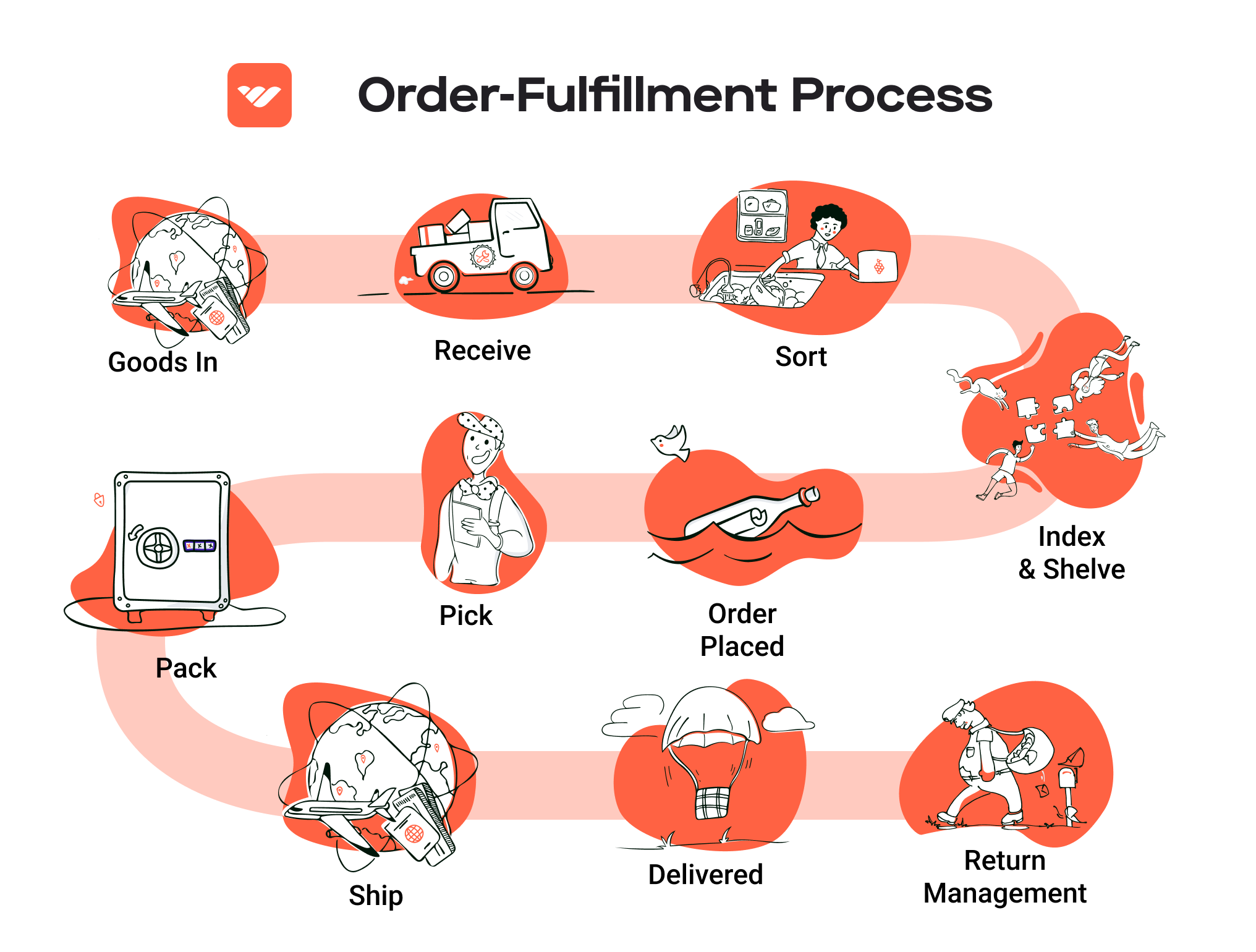
-
Customer Service: Amazon handles customer inquiries and returns, allowing sellers to focus on other aspects of their business.
-
Payment: After the sale, Amazon deposits the proceeds into the seller’s account, minus any applicable fees.
Pros of Using FBA
-
Prime Eligibility: Products fulfilled by Amazon are eligible for Amazon Prime, which offers free two-day shipping to millions of Prime members. This enhances visibility and can significantly increase sales.
-
Customer Trust: By utilizing FBA, sellers benefit from Amazon’s trusted brand reputation. Customers often feel more confident purchasing products that are fulfilled by Amazon due to the reliable service and return policies.
-
Multi-Channel Fulfillment: FBA allows sellers to use Amazon’s fulfillment services for sales made on other platforms, such as their own website or eBay. This flexibility can streamline logistics and inventory management.
-
Scalability: FBA enables businesses to scale quickly without the need to invest heavily in warehousing and logistics infrastructure. Sellers can focus on marketing and product development while Amazon manages fulfillment.
-
Automated Logistics: With FBA, sellers benefit from Amazon’s advanced technology and logistics systems, which can reduce the burden of shipping and order management.
Cons of Using FBA
-
High Fees: FBA comes with various fees, including storage fees and fulfillment fees. These costs can add up quickly, especially for sellers with low-margin products or those who keep inventory for extended periods.
-
Strict Inventory Rules: Amazon has strict inventory management policies, including limits on how much inventory can be stored at their fulfillment centers. This can pose challenges for sellers who experience fluctuations in demand.
-
Commingling Risks: FBA uses a commingling process where sellers’ products are mixed with those of other sellers. This can lead to issues if a customer receives a defective product from another seller, potentially harming the original seller’s reputation.
-
Less Control Over Shipping: While Amazon handles logistics, sellers have less control over shipping times and processes. If issues arise, sellers may find it challenging to address them promptly.
-
Dependency on Amazon: Relying on FBA can create a dependency on Amazon’s platform. Changes in Amazon’s policies or algorithms can directly impact a seller’s business.
Who is FBA Best For?
Fulfillment by Amazon is particularly well-suited for:
-
New Sellers: Those who are just starting their e-commerce journey can benefit from Amazon’s infrastructure and customer base, allowing them to focus on product sourcing and marketing.
-
High-Volume Sellers: Businesses with a high volume of sales can leverage FBA to efficiently manage logistics and customer service, freeing up resources for growth.
-
Sellers of Non-Seasonal Products: Sellers with consistent demand throughout the year can better manage costs associated with storage fees, making FBA a more viable option.
-
Multi-Channel Sellers: Businesses that sell on multiple platforms can streamline their fulfillment process through FBA, consolidating their logistics into one system.
-
Sellers Seeking Brand Trust: Those looking to enhance their brand’s credibility and visibility in the marketplace can benefit from the trust associated with Amazon’s fulfillment services.
In conclusion, Fulfillment by Amazon offers a robust solution for e-commerce sellers looking to scale their operations. While it comes with its own set of challenges and costs, the advantages of customer trust, efficient logistics, and Prime eligibility often outweigh the downsides for many businesses. By carefully weighing the pros and cons, sellers can determine if FBA aligns with their operational goals and growth strategies.
Core Services Offered by Fulfillment Centers
Inventory Management & Warehousing
Inventory management and warehousing are foundational services provided by fulfillment centers, essential for any e-commerce business aiming to scale efficiently. This service encompasses the storage, organization, and tracking of products within a warehouse. Fulfillment centers employ sophisticated inventory management systems that utilize barcodes and RFID technology to monitor stock levels in real-time, ensuring that businesses have up-to-date visibility of their inventory.
Benefits:
1. Space Optimization: By utilizing a third-party fulfillment center, e-commerce businesses can save on overhead costs associated with leasing and managing their own warehouse space. This is particularly beneficial for startups and small businesses that may not have the capital to invest in large facilities.
-
Inventory Accuracy: Advanced tracking systems reduce the risk of stock discrepancies, ensuring that businesses can maintain optimal inventory levels. This accuracy directly impacts order fulfillment rates, helping to avoid stockouts or overstock situations.
-
Scalability: As a business grows, so do its inventory needs. Fulfillment centers offer flexible storage solutions, allowing companies to scale up or down based on seasonal demand or business growth without the hassle of managing physical space.
Pick and Pack Services
Pick and pack services are crucial for the efficient processing of customer orders. This service involves the selection (picking) of products from the warehouse based on incoming orders, followed by packing those products for shipment. Fulfillment centers typically employ streamlined processes and trained staff to ensure that orders are picked accurately and packed securely.
Benefits:
1. Speed and Efficiency: Fulfillment centers are designed for high-volume operations, allowing for faster order processing than most in-house operations could achieve. This speed is vital for maintaining customer satisfaction, especially in a market where consumers expect quick delivery.
-
Accuracy in Fulfillment: The use of technology and systematic processes in picking and packing minimizes human error, ensuring that customers receive the correct items. This accuracy helps build trust and loyalty among customers.
-
Cost-Effectiveness: By outsourcing pick and pack services, businesses can reduce labor costs and increase operational efficiency. Fulfillment centers have the expertise and resources to manage these processes effectively, often at a lower cost than handling it in-house.
Kitting and Assembly
Kitting and assembly services involve combining multiple products into a single package or kit, which is particularly useful for businesses that sell bundled items or promotional packages. This service can also include the assembly of products that require some form of construction or preparation before shipping.
Benefits:
1. Enhanced Product Offering: Kitting allows e-commerce businesses to offer customized packages or bundles that can increase average order value. For example, a retailer could create a gift set that includes various related products, encouraging customers to purchase more.
-
Streamlined Operations: By outsourcing kitting and assembly to fulfillment centers, businesses can focus on their core activities, such as marketing and product development, without getting bogged down in the logistics of preparing products for sale.
-
Improved Customer Experience: Well-packaged kits can enhance the unboxing experience for customers, leading to higher satisfaction rates and increased chances of repeat purchases. A positive experience can significantly impact brand perception and loyalty.
Returns Management (Reverse Logistics)
Returns management, also known as reverse logistics, refers to the process of handling returned goods. This service is critical for e-commerce businesses, as online shopping often results in higher return rates compared to brick-and-mortar stores. Fulfillment centers manage the entire returns process, from receiving returned items to restocking and processing refunds.
Benefits:
1. Efficient Handling of Returns: A dedicated fulfillment center can streamline the returns process, ensuring that returns are processed quickly and efficiently. This efficiency minimizes the financial impact of returns on the business and enhances customer satisfaction.
-
Data Insights: Returns management services provide valuable insights into customer behavior and product performance. By analyzing return reasons, businesses can make informed decisions about inventory, product quality, and customer preferences.
-
Cost Reduction: Managing returns in-house can be resource-intensive and costly. Fulfillment centers leverage their infrastructure and expertise to minimize these costs, allowing businesses to maintain profitability even with higher return rates.
In summary, partnering with a fulfillment center offers e-commerce businesses a suite of core services that can enhance operational efficiency, improve customer satisfaction, and ultimately drive growth. By outsourcing inventory management, pick and pack, kitting, and returns management, businesses can focus on scaling their sales and enhancing their brand presence without getting overwhelmed by logistics.
How to Choose a Fulfillment Partner: A 6-Point Checklist
Location & Warehouse Network
The geographical location of your fulfillment partner is one of the most crucial factors to consider. A partner with strategically placed warehouses can drastically reduce shipping times and costs, enhancing customer satisfaction and your brand’s reputation.
Questions to Ask:
– Where are your warehouses located, and how does that align with our target market?
– What is your average shipping time for different regions?
– Do you have multiple warehouses to ensure more efficient distribution?
Technology & Integrations
In today’s digital landscape, the technology used by your fulfillment partner can significantly impact your operations. A robust fulfillment platform should integrate seamlessly with your e-commerce systems, providing real-time inventory tracking, order management, and analytics.
Questions to Ask:
– What technology platform do you use for order processing and inventory management?
– Can your system integrate with our existing e-commerce platform (e.g., Shopify, WooCommerce, Magento)?
– Do you provide an API for custom integrations, and how often is your technology updated?
Specializations (e.g., Cold Storage, Oversized Items)
Different businesses have unique requirements, and not all fulfillment partners can handle specialized needs. If your products require specific storage conditions (like temperature control) or have unique shipping requirements (like oversized items), ensure the partner you choose has the necessary capabilities.
Questions to Ask:
– What types of products do you specialize in fulfilling?
– Do you have facilities for cold storage or handling oversized items?
– What measures do you take to ensure product integrity during storage and shipping?
Scalability & Capacity
As your business grows, your fulfillment needs will evolve. It’s essential to choose a partner that can scale operations effectively without compromising service quality. Assess their capacity to handle spikes in order volume, especially during peak seasons.
Questions to Ask:
– What is your current capacity, and how quickly can you scale up during peak seasons?
– Have you successfully handled large volume increases for other clients in the past?
– How do you manage inventory overflow or backorders during high demand?
Pricing and Contracts
Understanding the pricing structure and contract terms is vital for maintaining profitability. Ensure you are clear on all costs, including storage fees, shipping charges, and any additional services that may incur extra fees.
Questions to Ask:
– Can you provide a detailed breakdown of your pricing model?
– Are there any hidden fees we should be aware of?
– What are the terms of the contract, and is there flexibility for renegotiation as our needs change?
Customer Support & Reviews
Exceptional customer support can make or break your partnership with a fulfillment provider. You want a partner who is responsive and proactive in addressing any issues that may arise.
Questions to Ask:
– What customer support channels do you offer (e.g., phone, email, chat)?
– What are your average response times for support inquiries?
– Can you provide references or reviews from current or past clients regarding your customer support?
Conclusion
Choosing the right fulfillment partner is a critical decision that can significantly impact your e-commerce business’s efficiency and customer satisfaction. By using this checklist, you can ensure that you assess potential partners comprehensively, making an informed decision that aligns with your business goals. Remember, a successful partnership is built on clear communication, mutual understanding, and a shared commitment to excellence in service delivery.
Understanding Fulfillment Pricing: A Breakdown of Common Fees
Initial Setup Fees
Initial setup fees are one-time charges that cover the costs associated with onboarding your business into a fulfillment center. This may include the configuration of your inventory system, integration with your e-commerce platform, and the establishment of your account.
The calculation of initial setup fees varies significantly among fulfillment providers. Some may charge a flat fee, while others might base the cost on the complexity of the integration. Generally, expect to pay anywhere from $50 to $500 or more, depending on the size of your operation and the specific services required.
Tip: Always request a detailed breakdown of what the initial setup fee covers to avoid unexpected costs later.
Receiving Fees
Receiving fees apply when your inventory arrives at the fulfillment center. This fee covers the labor involved in unloading, checking, and storing your products. The costs can vary based on the volume of items received and the complexity of the handling process.
Typically, receiving fees are calculated on a per-unit basis or as a flat fee for a shipment. For example, a fulfillment center may charge $0.20 to $1.00 per item, or a set fee like $50 for every shipment received.
Tip: To minimize receiving fees, consider consolidating shipments and ensuring that your products are well-packaged and labeled to facilitate quicker processing.
Storage Fees (per pallet/bin)
Storage fees are recurring charges that apply for the space your inventory occupies in the fulfillment center. These fees are usually calculated on a monthly basis and can be assessed per pallet, bin, or square foot.
The rates can vary widely, generally ranging from $5 to $20 per pallet per month, or $0.10 to $0.50 per cubic foot. Some providers may offer tiered pricing based on the volume of storage you require; for instance, the more pallets you store, the lower the per-pallet fee.
Tip: Regularly review your inventory levels and turnover rates to optimize storage costs. Consider negotiating terms with your fulfillment provider if you have consistent high-volume storage needs.
Pick & Pack Fees (per item/order)
Pick and pack fees cover the labor costs associated with selecting items from inventory and packing them for shipment. This fee can vary based on the number of items in an order, the complexity of the packing requirements, and any additional services such as gift wrapping or special packaging.
These fees are generally charged per item or per order. For example, a fulfillment center might charge $1.00 to $3.00 per item for picking and packing, or a flat rate of $2.00 to $5.00 per order, regardless of the number of items.
Tip: Streamline your product offerings and order processes to reduce pick and pack fees. Implementing efficient inventory management and order processing systems can lead to significant savings.
Shipping Fees
Shipping fees are one of the most significant components of fulfillment pricing and can vary greatly based on several factors: the shipping carrier, the destination, the weight and dimensions of the package, and the shipping method (e.g., standard, expedited, or same-day delivery).
Shipping fees are typically calculated based on a combination of dimensional weight and actual weight, with charges varying by carrier. For instance, you might see costs ranging from $5 to $20 for standard shipping, depending on the size and weight of the package and the delivery speed.
Tip: To get the best shipping rates, consider negotiating bulk shipping discounts with carriers or utilizing fulfillment providers that have established partnerships with major shipping companies.
Conclusion: Tips for Getting an Accurate Quote
When seeking fulfillment pricing, it’s crucial to obtain a detailed and transparent quote from potential providers. Here are some tips to ensure you get an accurate estimate:
-
List Your Requirements: Clearly outline your inventory size, types of products, expected order volume, and any special handling needs.
-
Ask for Itemized Quotes: Request a breakdown of all fees, including setup, receiving, storage, pick & pack, and shipping fees.
-
Consider Seasonal Variations: Inquire about how fees may change during peak seasons, such as holidays or sales events.
-
Negotiate Terms: Don’t hesitate to negotiate pricing and terms based on your expected volume and long-term partnership potential.
-
Request Performance Metrics: Ask for data on fulfillment accuracy, shipping times, and customer service responsiveness, which can affect your overall costs.
By understanding these common fees and following these tips, you can make informed decisions that will help streamline your fulfillment operations and support your business’s growth.
Frequently Asked Questions (FAQs) about Fulfillment
1. What is the antonym of fulfillment?
The antonym of fulfillment is typically non-fulfillment or failure. These terms refer to the lack of completion or realization of an objective, project, or expectation.
2. How does non-fulfillment impact e-commerce businesses?
Non-fulfillment can lead to customer dissatisfaction, increased return rates, and negative reviews, which ultimately affect a business’s reputation and sales. It can also result in lost revenue due to missed sales opportunities and operational inefficiencies.
3. What’s the difference between a warehouse and a fulfillment center?
A warehouse is primarily used for storage of goods, whereas a fulfillment center is a specialized facility designed to manage the entire order process—from receiving inventory to picking, packing, and shipping orders directly to customers. Fulfillment centers often have technology and processes in place to optimize order accuracy and speed.
4. What is a 3PL (Third-Party Logistics)?
A 3PL refers to a company that provides outsourced logistics services, which can include warehousing, transportation, and fulfillment. They help businesses manage their supply chain more efficiently by leveraging their expertise and resources, often resulting in cost savings and improved service levels.
5. How much do fulfillment services cost?
Fulfillment service costs vary widely based on factors such as order volume, storage needs, shipping methods, and the complexity of the services provided. Typically, businesses can expect to pay a per-order fee, a storage fee for the inventory held, and additional charges for packaging and shipping. It’s advisable to request quotes from multiple providers to compare costs effectively.
6. What are common causes of fulfillment failure?
Common causes of fulfillment failure include inventory mismanagement, poor order processing systems, lack of staff training, and shipping errors. Additionally, unexpected spikes in demand or supply chain disruptions can exacerbate fulfillment challenges.
7. How can businesses avoid fulfillment issues?
To avoid fulfillment issues, businesses should invest in inventory management software, establish clear communication channels with suppliers, regularly train staff, and continuously assess and improve their fulfillment processes. Implementing automation can also enhance efficiency and accuracy.
8. What role does customer feedback play in fulfillment?
Customer feedback is crucial in identifying pain points in the fulfillment process. It helps businesses understand customer expectations, improve service quality, and make necessary adjustments to their operations to enhance overall satisfaction and loyalty.
9. How can technology improve fulfillment efficiency?
Technology can streamline various aspects of fulfillment, including inventory tracking, order processing, and shipping. Solutions such as warehouse management systems (WMS), order management systems (OMS), and automated picking systems can significantly reduce errors and improve speed.
10. What are the key metrics to measure fulfillment success?
Key metrics for measuring fulfillment success include order accuracy rate, order cycle time, inventory turnover, shipping time, and customer satisfaction scores. Monitoring these metrics helps businesses identify areas for improvement and optimize their fulfillment strategies.
Conclusion: Is Outsourcing Fulfillment the Right Move for Your Business?
Weighing the Benefits of Outsourcing Fulfillment
Outsourcing fulfillment can be a transformative decision for e-commerce businesses aiming for growth and efficiency. By leveraging a fulfillment service, companies can save significant time and resources, allowing them to focus on core business activities such as marketing and product development. With fulfillment experts managing inventory, order processing, and shipping logistics, businesses can streamline operations and enhance customer satisfaction through faster delivery times and reduced errors.
Moreover, scalability becomes seamless when partnering with a fulfillment provider. As your business grows, so do your logistics needs. A capable fulfillment partner can easily accommodate fluctuations in order volume, whether during peak seasons or unexpected surges in demand. This flexibility ensures that your business can adapt to market changes without the burden of overextending internal resources.
Expertise is another critical advantage. Fulfillment services bring specialized knowledge in logistics, inventory management, and shipping regulations. This expertise not only minimizes potential pitfalls but also allows businesses to take advantage of best practices and innovative technologies that can further optimize fulfillment processes.
However, it is crucial to select the right fulfillment partner. The success of outsourcing hinges on finding a provider that aligns with your specific business needs and values. Consider factors such as their technology capabilities, shipping options, and responsiveness to customer service. A well-chosen partner can significantly impact your growth trajectory.
Call to Action
To determine if outsourcing fulfillment is the right move for your business, conduct a thorough audit of your current shipping processes. Evaluate your operational efficiency, costs, and customer satisfaction levels. This assessment will help you identify gaps and opportunities where a fulfillment partner could enhance your business model. Take the first step towards scaling your operations by exploring potential fulfillment services that align with your goals.
Important Disclaimer
⚠️ Important Disclaimer
The information in this guide is for educational purposes. Fulfillment services, pricing, and platform features change frequently. Always conduct your own due diligence and consult with providers directly before making business decisions.

